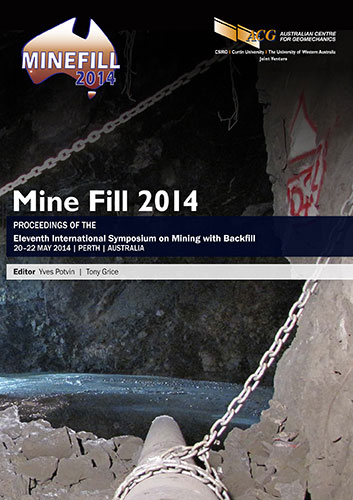Investigation into the development of foam mine fill

|
Authors: Hefni, M; Hassani, FP; Nokken, M; Kermani, M; Vatne, D |
DOI https://doi.org/10.36487/ACG_rep/1404_02_Hefni
Cite As:
Hefni, M, Hassani, FP, Nokken, M, Kermani, M & Vatne, D 2014, 'Investigation into the development of foam mine fill', in Y Potvin & T Grice (eds), Mine Fill 2014: Proceedings of the Eleventh International Symposium on Mining with Backfill, Australian Centre for Geomechanics, Perth, pp. 49-59, https://doi.org/10.36487/ACG_rep/1404_02_Hefni
Abstract:
This study is part of large and an ongoing investigation into the development of a light-weight and highly fluid mine fill for various applications in mining and civil operations. Foam mine fill (FMF) is the new material proposed for backfilling mines, and is fabricated by mixing stable foam into a mixture of tailings, binders, and water. This paper presents the results of a preliminary experimental study, in which FMF samples were prepared under different binder dosages, pulp densities, and amount of air entrained. FMF samples were prepared using tailings from a copper mine as the inert material, Normal Portland Cement as the main binding agent, and a foaming agent with a foam generator. Samples were cured for 28 days and subjected to unconfined compressive strength (UCS) testing. Select samples were subjected to mercury intrusion porosimetry to study the microstructural properties. An empirical model was developed using a response surface methodology to determine the optimal settings for the factors investigated, and to produce the first reference sample with a 28 day UCS value of 1 MPa.
References:
Anderson, MJ & Whitcomb, PJ 2005, RSM Simplified, Productivity Press, New York, New York.
ASTM International 2010, ASTM C260: Standard Specification for Air-Entraining Admixtures for Concrete, ASTM International, West Conshohocken.
ASTM International 2006a, ASTM C136-06: The Standard Test Method for Sieve Analysis of Fine and Coarse Aggregates, ASTM International, West Conshohocken.
ASTM International 2006b, ASTM D2166-06: Standard Test Method for Unconfined Compressive Strength of Cohesive Soil, ASTM International, West Conshohocken.
Benzaazoua, M, Belem, T & Bussière, B 2002, ‘Chemical factors that influence the performance of mine sulphidic paste backfill’, Cement and Concrete Research, vol. 32, no. 7, pp. 1133-44.
Brown, ET 1981, Rock Characterization, Testing & Monitoring: ISRM Suggested Methods, Pergamon Press, Oxford, Oxfordshire.
Cellcrete Technologies Inc. 2013, Cellcrete Technologies Inc: Cellular Paste Backfill, Cellcrete Technologies Inc., Blaine, viewed 27 November 2013, .
Cellular Concrete Technologies, Inc. 2013, Stable Air® Foaming Agent, Cellular Concrete Technologies, Inc., Irvine, viewed 27 November 2013, .
Glocal ChemVentures Pvt. Ltd. 2013, Making of Foamed Concrete, Glocal ChemVentures Pvt. Ltd., Mumbai, viewed 15 October 2013, .
Hassani, FP & Archibald, JF 1998, Mine Backfill, Canadian Institute of Mining, Metallurgy and Petroleum, Westmount.
Marquez, G & Hassani, F 2010, An Investigation into Foam Backfill, report prepared by McGill University, Montréal.
Narayanan, N & Ramamurthy, K 2000, ‘Structure and properties of aerated concrete: a review’, Cement and Concrete Composites, vol. 22, no. 5, pp. 321-9.
Panesar, D 2013, ‘Cellular concrete properties and the effect of synthetic and protein foaming agents’, Construction and Building Materials, vol. 44, pp. 575-84.
Tarasov, A, Kearsley, E, Kolomatskiy, A & Mostert, H 2010, ‘Heat evolution due to cement hydration in foamed concrete’, Magazine of Concrete Research, vol. 62, no. 12, pp. 895-906.
© Copyright 2025, Australian Centre for Geomechanics (ACG), The University of Western Australia. All rights reserved.
View copyright/legal information
Please direct any queries or error reports to repository-acg@uwa.edu.au
View copyright/legal information
Please direct any queries or error reports to repository-acg@uwa.edu.au